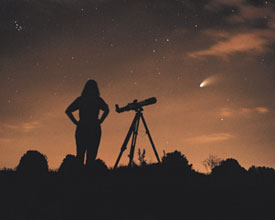
Mark Schroeder
Did you know you can see a galaxy 2½ million light-years away with your unaided eyes? Craters on the Moon with binoculars? Countless wonders await you any clear night. The first step in astronomy for beginners is simply to look up and ask, "What's that?" Begin gazing at the stars from your backyard, and you'll be taking the first step toward a lifetime of cosmic exploration and enjoyment.
But what, exactly, comes next? Too many newcomers to astronomy get lost in dead ends and quit in frustration. Astronomy for beginners shouldn't be that way.
What advice would help beginners the most? A while ago, the Sky & Telescope editors got together to brainstorm this question about astronomy for beginners. Pooling thoughts from more than 100 years of collective experience answering the phones and mail, we came up with the following pointers to help newcomers past the most common pitfalls and onto the likeliest route to success.
Learn the Night Sky with the Unaided Eye
Astronomy is an outdoor nature hobby, so the best way to begin is to go out into the night and learn the starry names and patterns overhead.
- Use the monthly naked-eye star charts in Sky & Telescope magazine
- Download our free Getting Started in Astronomy flyer (with bimonthly maps)
- Buy yourself an inexpensive planisphere, which shows the constellations visible at any time throughout the year.
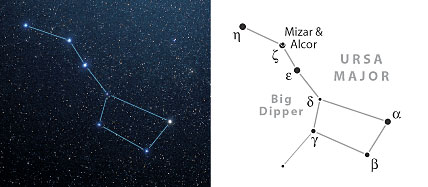
Akira Fujii
Even if you live in a densely populated, light-polluted area, there's more to see up there than you might imagine. The ability to look up and say, "There's Polaris" or "That's Saturn" will provide pleasure, and perhaps a sense of place in the cosmos, for the rest of your life.
Thinking Telescope? Start Stargazing with Binoculars Instead
Binoculars make an ideal "first telescope" for several reasons:
- Binoculars show you a wide field of view, making it easy to find your way around. A higher-power telescope magnifies only a tiny, hard-to-locate bit of sky.
- They also show a view that's right-side up and straight in front of you, making it easy to see where you're pointing. An astronomical telescope's view, by contrast, is often upside down, is sometimes mirror-imaged as well, and is usually presented at right angles to the direction you're aiming.
- Binoculars are also relatively cheap, widely available, and a breeze to carry and store.
The performance of binoculars is surprisingly respectable. Ordinary 7- to 10-power binoculars improve on the naked-eye view about as much as a good amateur telescope improves on the binoculars — for much less than half the price.
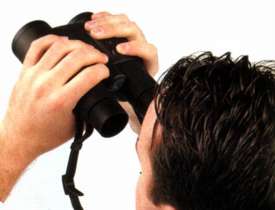
SkyWatch / Chuck Baker
For astronomy, the larger the front lenses the better. High optical quality is also important, more so than for binoculars that are used on daytime scenes. Modern image-stabilized binoculars are a tremendous boon for astronomy (though expensive), but any binoculars that are already knocking around the back of your closet are enough to launch an amateur-astronomy career.
Dive into Maps and Guidebooks
Once you have the binoculars, what do you do with them? You can have fun looking at the Moon and sweeping the star fields of the Milky Way, but that will wear thin pretty fast. However, if you've learned the constellations and obtained detailed sky maps, binoculars can keep you happily busy for years.
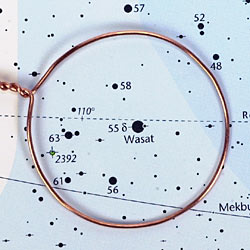
Sky & Telescope
They'll reveal dozens of star clusters, galaxies, and nebulae. They'll show the ever-changing positions of Jupiter's moons and the crescent phases of Venus. You can identify dozens of craters, plains, and mountains on the Moon. You can split scores of interesting double stars and follow the fadings and brightenings of numerous variable stars. If you know what to look for.
A sailor of the seas needs top-notch charts, and so does a sailor of the skies. Fine maps bring the fascination of hunting out faint secrets in hidden sky realms. Many astronomy for beginners guidebooks describe what's to be hunted and the nature of the objects you find. Moreover, the skills you'll develop using binoculars to locate these things are exactly the skills you'll need to put a telescope to good use.
Plan indoors what you'll do outdoors. Spread out your charts and guides on a big table, find things that ought to be in range of your equipment, and figure out how you'll get there. Plan your expeditions before heading out into the nightly wilderness.
Ransack Your Public Library
The joys of astronomy come from intellectual discovery and knowledge of the cryptic night sky. But you have to make these discoveries and gain this knowledge, often by yourself.
For beginners in astronomy, one of your most important tools will be your public library. Comb the astronomy shelf for books with the basic knowledge you need to know, and for guidebooks to what you can see out there in the wide universe. Read about those stars and constellations you're finding with the naked eye, and about how the stars change through the night and the seasons.
While there are a lot of valuable reference books, there are a few perennial favorites:
- Nightwatch: A Practical Guide to Viewing the Universe by Terence Dickinson
- The Backyard Astronomer's Guide by Terence Dickinson and Alan Dyer
- Binocular Highlights, 2nd edition by Gary Seronik
- The Monthly Sky Guide, 10th edition by Ian Ridpath and Wil Tirion
Also make sure to check the magazine racks for Sky & Telescope. It offers a big, user-friendly sky map each month, observing tips and projects for all skill levels, and reports on frontline astronomical research.
Of course, websites can be a tremendous resource, but they can also be somewhat hodgepodge. There are excellent beginner's sites (hey, you found this one!), but for a coherent, well-organized framework into which to put the knowledge that you will pick up as you go along, you'll need books. Go to the library.
Keep an Astronomy Diary
This one is optional. But we keeping an observing logbook of what you do and see can help you get more out of the hobby. Keeping a record concentrates the mind — even if it's just a jotting like "November 7th — out with the 10x50 binocs — clear windy night — NGC 457 in Cassiopeia a faint glow next to two brighter stars." Get a spiral-bound notebook and keep it with the rest of your observing gear. Being able to look back on your early experiences and sightings in years to come gives deeper meaning to your astronomy for beginners activities now.
For some people, anyway. If this isn't your thing or becomes too much of a chore, never mind.
Seek Out Other Amateurs
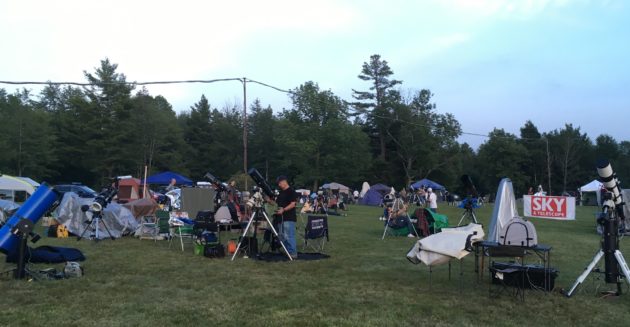
S. N. Johnson-Roehr / S&T
Self-education is fine as far as it goes, but there's nothing like sharing an interest with others. Hundreds of astronomy clubs exist worldwide; see our clubs listing. Call or e-mail a club near you, or check out its web site, and see when it holds meetings or nighttime observing sessions — "star parties." These events, some of which draw hundreds of amateurs, can offer a fine opportunity to try different telescopes, learn what they will and will not do, pick up advice and new skills, and make friends.
Astronomy clubs range from tiny to huge, from moribund to vital, from ingrown to extremely welcoming of newcomers. You'll have to check them out yourself. But none would be publicizing themselves in our directory if they weren't hoping that you would call.
When It's Time for a Telescope, Plunge in Deep
Eventually you'll know you're ready. You'll have spent hours poring over the ads and reviews. You'll know the different kinds of telescopes, what you can expect of them, and what you'll do with the one you pick.
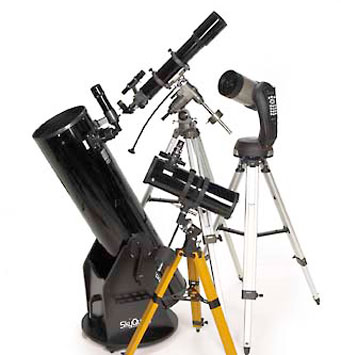
Sky & Telescope / Craig Michael Utter
This is no time to skimp on quality; shun the flimsy, semi-toy "department store" scopes that may have caught your eye. The telescope you want has two essentials. The first is a solid, steady, smoothly working mount. The second is high-quality, "diffraction-limited" optics.
Naturally you'll also want large aperture (size), but don't lose sight of portability and convenience. Remember, the best telescope for astronomy for beginners is the one you'll use most. Sometimes gung-ho novices forget this and purchase a huge "white elephant" that is difficult to carry, set up, and take down, so it rarely gets used. How good an astronomer you become depends not on what your instrument is, but on how much you use it. (For more specific tips on buying, see "A Guide to Choosing a Telescope").
Many new telescopes have built-in computers and motors that can, in theory, point the scope to any celestial object at the push of a few buttons (after you do some initial setup and alignment). These "Go To" scopes are fun to use and can certainly help you locate sights you might otherwise overlook. But opinions in the amateur-astronomy world are divided about whether "flying on automatic pilot," at least for beginners, keeps you from learning to fly on your own. We think it's important, at least for backup purposes, to be able to use your charts and constellation knowledge to find telescopic objects by yourself — especially if the scope's batteries die after you've driven 50 miles to a dark-sky location!
And as Terence Dickinson and Alan Dyer say in their Backyard Astronomer's Guide, "A full appreciation of the universe cannot come without developing the skills to find things in the sky and understanding how the sky works. This knowledge comes only by spending time under the stars with star maps in hand and a curious mind." Without these, "the sky never becomes a friendly place."
It's true that telescopes can cost thousands of dollars, but some good ones can be had for only a few hundred. Can't afford the scope you want? Save up until you can. More time using binoculars while building a telescope fund will be time you'll never regret.
If you choose to start with a small but high-quality scope, it can serve as your traveling companion for a lifetime — whenever it's impractical to bring along the big, more expensive scope that you eventually buy after your commitment to the hobby has passed the test of time.
Lose Your Ego
Astronomy teaches patience and humility — and you had better be prepared to learn them. Not everything will work the first time. You'll hunt for some wonder in the depths and miss it, and hunt again, and miss it again. This is normal. But eventually, with increasing knowledge, you will succeed.
There's nothing you can do about the clouds that move in to block your view, the extreme distance and faintness of the objects of your desire, or the special event that you missed because you got all set up one minute late. The universe will not bend to your wishes; you must take it on its own terms.
Most objects that are within the reach of any telescope, no matter what its size, are barely within its reach. So most of the time you'll be hunting for things that appear very dim or very small, or both. You need the attitude that they will not come to you; you must go to them.
Relax and Have Fun
Part of losing your ego is not getting upset at your telescope because it's less than perfect. Perfection doesn't exist, no matter what you paid. If you find yourself getting wound up over Pluto's invisibility or the aberrations of your eyepiece, take a deep breath and remember why you're doing this. Astronomy for beginners should be calming and fun.
Learn to take pleasure in whatever your instrument can indeed show you. The more you look and examine, the more you will see — and the more you'll become at home in the night sky. Set your own pace, and delight in the beauty and mystery of our amazing universe.
 2
2









Comments
Tulsa
April 3, 2017 at 12:04 pm
Thanks Alan! This was really helpful! My dad and I are searching for a telescope and we are starting to become beginner astronomers! Thanks again for your tips!
You must be logged in to post a comment.
marteenleon
April 26, 2017 at 11:25 am
Hello Alan,
I'm glad I found your article. I have looked up to the sky since I remembered. I got fascinated when my uncle bought his first telescope (Dobsonian Tasco) and used it every time I visited him. I have a crush on the moon, so I'm always looking for a way to look or take pictures at it. Now I have decided to make the step and buy, not sure what, a telescope or a pair of binoculars. My budget is tight, so I found that the Celestron Firstscope is very affordable and have very good reviews. But I have read also that a good pair of binoculars will be a good start too. I have now a 7x45 pair, so I will have to get a 10x50.
In the meantime, I'm building a reflective telescope to get more understanding of how they work.
Anyway, I will appreciate your comments and guidance to make my decision on what to get.
Thank you and have good sights.
Martin
You must be logged in to post a comment.
You must be logged in to post a comment.